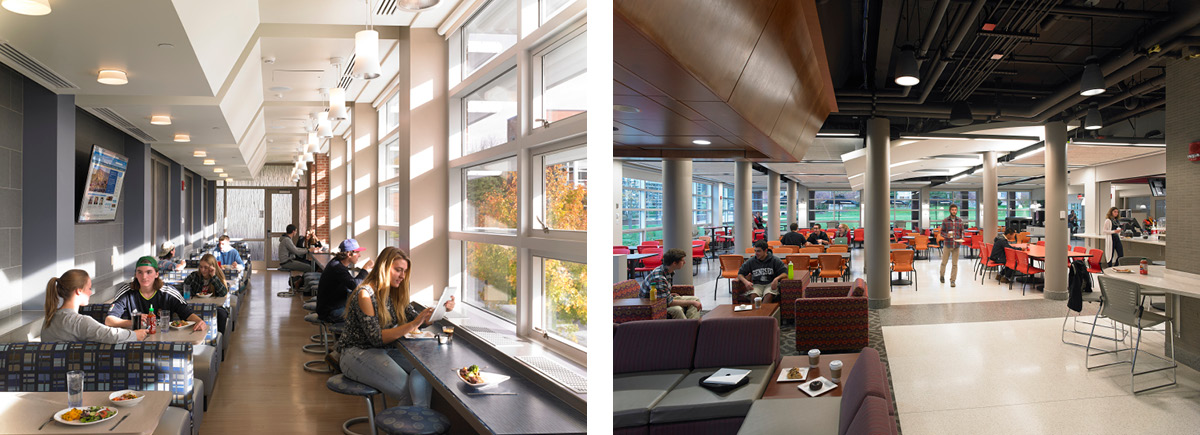Gone are the days where a dining hall was just a place to grab a quick bite.
From catching up with friends over a slice of pizza to tackling a group project over a cup of coffee, a well-designed dining hall has become an essential part of a student’s college experience.
Now, with the rising demand for visually appealing dining settings and diverse dietary options, institutions are under immense pressure to revamp their facilities. And for good reason—these spaces can greatly influence student satisfaction and enrollment.
Optimizing Dining Facility Design Through Stakeholder Engagement
Whether adding onto or renovating a dining facility, gathering direct feedback from students, faculty and staff is an effective way to identify emerging trends and key areas for improvement.
For instance, student surveys or in-person focus groups can reveal strong opinions regarding available menu options, seating arrangements, circulation near serving or checkout lines, and the overall atmosphere. This valuable intel helps generate layouts that alleviate pain points and appeal to all.

The students at Warren Wilson College have always been engaged in sustainable, on-site farming and animal husbandry to provide food for the campus and the surrounding community. Their feedback was incorporated into the design of an eco-conscious food service kitchen, ensuring that the college continued to drive healthy living and hands-on environmental stewardship.
Design Decisions That Cater to Expanding Meal Variety
For some prospective students, a dining hall that caters to their nutritional preferences—or lack thereof—can make or break their decision to attend.
Institutions may therefore benefit from collaborating with their food service provider and current students to develop menus that accommodate a variety of dietary needs or preferences, including vegan and vegetarian selections; non-allergenic options like gluten-free, dairy free and nut-free foods; and foods that reflect their cultural or religious practices.
These results will inform strategic design support, often with the integration of specialized cooking equipment, like separate fryers, utensils and processes to prevent potential cross-contamination.
Moreover, partnering with popular national restaurant chains to envision trendy food stations serves as an effective strategy to attract more students and increase revenue through franchise fees, licensing agreements and boosted sales.

NC State University transformed its iconic Atrium Food Court into a contemporary dining venue that consolidates several “micro-restaurants” into one location. The Atrium now offers a wide range of options including sushi, pizza and pasta dishes, custom salads and sandwiches, a Chick-Fil-A Express and a “Wolfpack-to-Go” takeout section, and saw a sharp increase in the number of meals served per day after reopening.
Shaping a Dynamic Campus Identity
The most personalized campus dining encounters evoke a strong sense of belonging for all individuals. They boast a myriad of seating types such as bar-height, secluded nooks that cater to more introverted students as well as expansive tables and couches that facilitate communal dining experiences.
Recent trends have also seen dining halls reimagined as multi-functional areas that closely resemble 24/7 student centers. These spaces may incorporate laptop charging stations; self-serve kiosks, digital menus and mobile ordering systems; and flexible areas for campus events, lectures and entertainment.
These enhancements can transform dining halls into sought-after places for students to recharge, gather and socialize in whichever way they prefer, nourishing both their minds and appetites.

The evolution of Letchworth Dining Hall at The State University of New York at Geneseo perfectly illustrates how a versatile dining area can become the central hub of student activity; the space features a blend of shared booths and bar seating, along with conventional restaurant-style tables and a community “living-room.”
A New Era of Campus Dining
As colleges and universities transition from extended periods of remote and hybrid education to fully-in person learning, it’s clear that the significance of dining halls has grown. Much was learned during the pandemic, and we are still feeling its impact, but dining halls can provide connections in a way few other spaces can.
What were once ordinary cafeterias have become powerful tools for fostering campus fellowship and even a sense of home; and by investing in these vital spaces, institutions can offer the immersive culinary experiences that students crave and cultivate a sense of community for generations to come.

